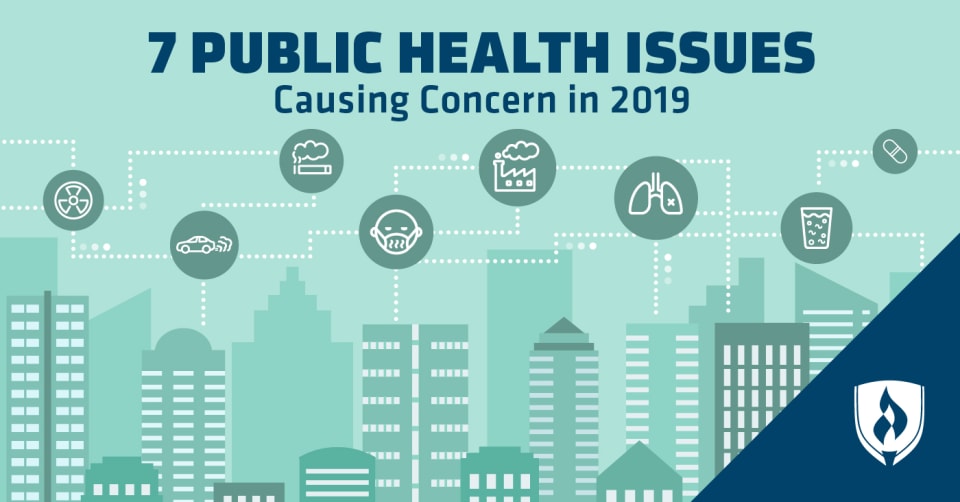You’re hearing news of increased public health concerns nearly every day. With your vested interest in healthcare, it’s not surprising that public health problems like antibiotic-resistant superbugs are on your radar.

Seeing that these developments in public health issues are making national news has you curious: How do experts decide what counts as a public health threat? What are the most pressing public health concerns you should be aware of?
We’re examining what qualifies as a public health concern, which public health trends have experts worried and what you can do to contribute to a healthier community.
How do experts determine public health threats?
Public health professionals identify and prevent health problems that impact entire communities, regions or populations (such as children or those living in poverty). These experts look for key criteria when determining which issues qualify as public health concerns.
“A public health threat is an illness with public health significance”—that is, a pathogen that can be transmitted between people and that raises the risk of death or serious injury to a certain group of people, according to Adriano de Bernardi Schneider, PhD, a postdoctoral scholar in the department of medicine at the University of California, San Diego.
“When on the lookout for red flags, you are always looking for a shift on the trend of the disease,” de Bernardi Schneider says. This includes both how quickly a disease is spreading as well as its behavior. If a disease becomes more aggressive, it’s going to catch the attention of public health professionals.
However, not all public health issues are infectious diseases. Concerns like natural disasters and addiction can also have a negative effect on large groups of people. The Centers for Disease Control and Prevention (CDC) consider these types of issues to be public health threats when they become “leading causes of death and disability.”
7 Public health issues causing concern in 2019
Experts are calling these the top public health concerns in 2019. Keep an eye on their development and learn what you can do to make your community a healthier place.
1. Antibiotic-resistant microbes
“If I had to name a single public health threat not only in America but in the world, I would say the antimicrobial resistance,” de Bernardi Schneider says. These “superbugs” have grown more resistant to treatment after years of antibiotics being frequently prescribed in situations where they may not be necessary, such as with viral illnesses.
“The levels of resistance to drugs by bacteria, parasites, viruses and fungi continue to climb, making treatment to certain diseases, such as tuberculosis, HIV and malaria, more challenging each day that passes,” de Bernardi Schneider says. Patients who are prescribed antibiotics are encouraged to take their full course in an effort to slow microbial resistance.
2. Air pollution
Air pollution is a global public health concern, with the World Health Organization’s (WHO) calling it “the greatest environmental risk to health” in 2019. Air pollution affects the lungs, heart and brain and can lead to conditions like cancer, stroke and cardiovascular disease. The WHO estimates 7 million people die each year from diseases caused by air pollution.
Air pollution is caused by everyday activities in homes and businesses that burn fossil fuels. Though many parts of the world are working to reduce the emissions they put into the air, the CDC also encourages people to manage their exposure to air pollution by using the Environmental Protection Agency’s (EPA) air quality indicator before spending time outside.
3. Opioid epidemic
Opioids are a type of drug that includes fentanyl, heroin and prescription painkillers like oxycodone and morphine. Opioids are highly addictive, and dependence on and abuse of these drugs has been growing for decades. The opioid epidemic was declared a public health emergency in 2017, the same year that opioid use was the cause of 68 percent of all deaths by drug overdose.1
Healthcare providers, pharmacies and government agencies are now working together to reverse this crisis. The Department of Health and Human Services (HHS) offers five guidelines to decrease opioid abuse, including increased access to rehabilitation services, developing better methods of pain management and using overdose-reversing drugs.2
4. Obesity
Obesity affects more than 93 million adults and more than 13.7 million children and adolescents.3 Obesity is about far more than just being overweight. It’s recognized as a leading cause of premature death through related conditions like type 2 diabetes, heart disease, stroke and some types of cancer.
The CDC recognizes that obesity is a complex issue with no simple solution. It stems from a variety of factors, including genetics, physical activity, access to proper nutrition and community environment. The CDC offers educational tools to help promote healthier lifestyles across communities, including local resources that promote nutrition and exercise education.
5. Alcohol and tobacco use
They may not be the most surprising things on this list, but alcohol and tobacco use both have far-reaching effects that can impact public health for years to come. Tobacco use is associated with cancer, heart disease, lung disease and diabetes as well as increased problems with the immune system. Excessive alcohol use has short-term effects, such as alcohol poisoning and injuries, and long-term effects like liver disease, high blood pressure and certain mental health problems.
Increased taxes and stricter regulations around purchasing alcohol and tobacco are becoming more common, and increased education about the risks of these activities is regularly used to discourage these public health issues.
6. Influenza pandemic
Flu pandemics occur when the illness spreads rapidly across the globe, infecting a significant portion of the world’s population. These pandemics have occurred four times in the past century, with the most recent being the 2009 outbreak. Experts believe we’re due to see another flu pandemic soon, which is why this threat has landed on the WHO’s list of global health problems in 2019.4
In the U.S., each state develops its own plan to keep residents safe from this public health threat in case of an outbreak. The WHO also provides flu vaccines and other resources to countries across the globe, especially developing nations, in the hopes of preventing this public health threat from becoming a reality.
7. Motor vehicle accidents
The CDC reports that motor vehicle crashes continue to be a leading cause of death in the U.S., with more than 100 people dying each day.5 An additional 2.5 million people per year spent time in the emergency room due to injuries from vehicle crashes.5
Education around distracted driving, seat belt safety and teen driver safety are high priorities for improving this public health issue. More states are passing distracted driving laws and stricter regulations for new drivers, along with increased training on the proper use of car seats and booster seats, in an effort to keep everyone safe on the road.
Examining the state of public health
These public health issues affect people around the nation and the world. Thanks to the public health professionals who work to solve these problems, we can all look forward to healthier communities in the future.
If you’re curious about how public health professionals make a difference with their work each day, check out our article “Health Information Trends: What Is Population Health?”
1U.S. Department of Health and Human Services, Centers for Disease Control and Prevention, CDC’s Response to Opioid Overdose Epidemic, [accessed July 2019] https://www.cdc.gov/opioids/strategy.html
2U.S. Department of Health and Human Services, Secretary Price Announces HHS Strategy for Fighting Opioid Crisis [accessed July 2019] https://www.hhs.gov/about/leadership/secretary/speeches/2017-speeches/secretary-price-announces-hhs-strategy-for-fighting-opioid-crisis/index.html
3U.S. Department of Health and Human Services, Centers for Disease Control and Prevention, Overweight & Obesity: Data & Statistics [accessed July 2019] https://www.cdc.gov/obesity/data/index.html
4World Health Organization, Ten threats to global health in 2019, [accessed July 2019] https://www.who.int/emergencies/ten-threats-to-global-health-in-2019
5U.S. Department of Health and Human Services, Centers for Disease Control and Prevention, Motor Vehicle Safety – Cost Data and Prevention Policies [accessed July 2019] https://www.cdc.gov/motorvehiclesafety/costs/index.html




